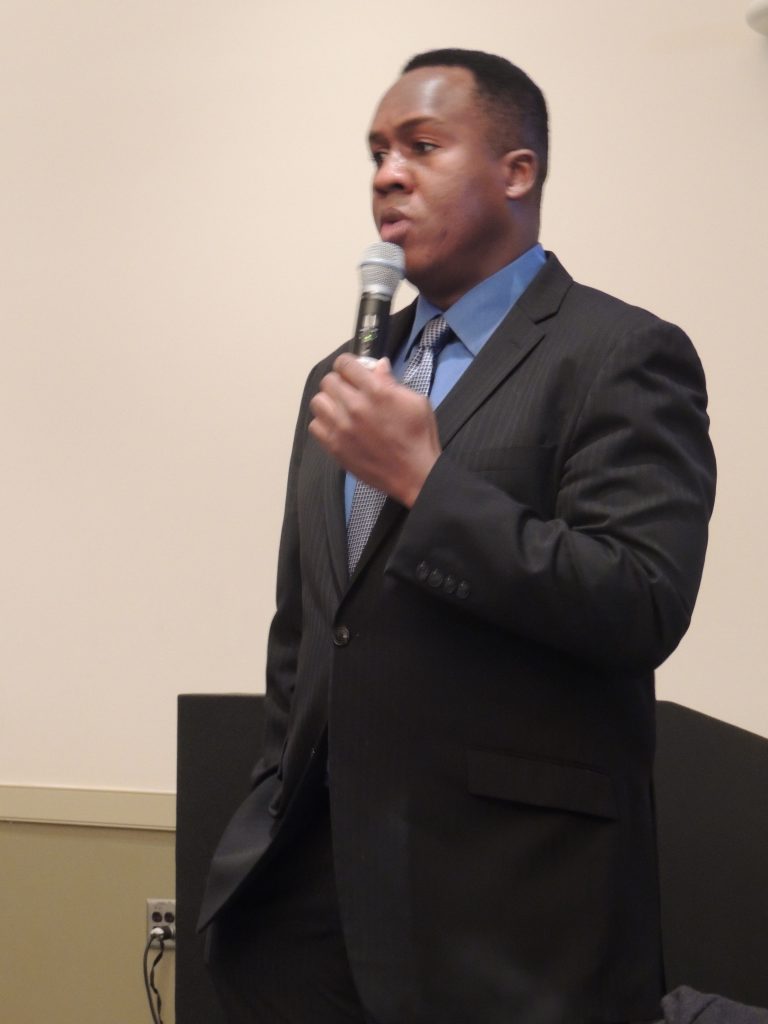
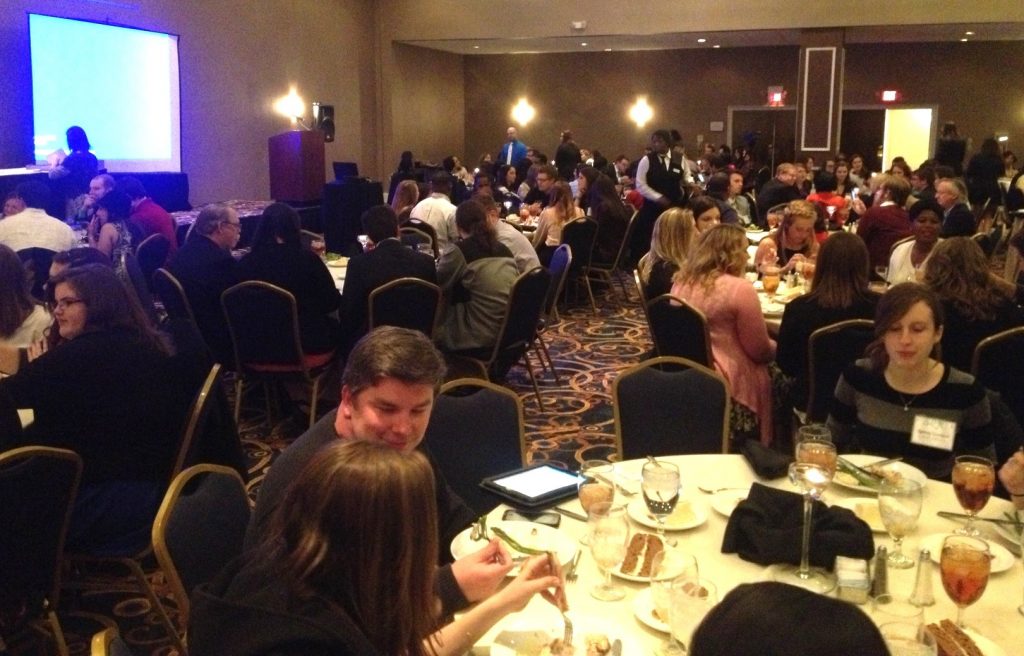
Photo by Robert Buckman


Photo by Robert Buckman




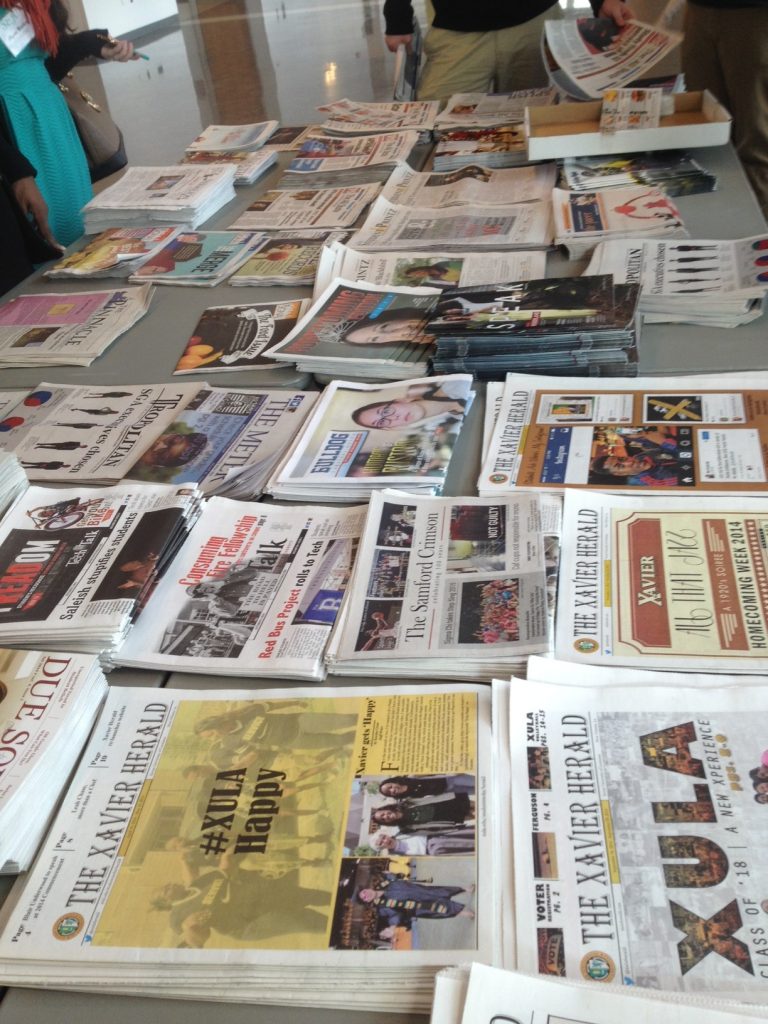
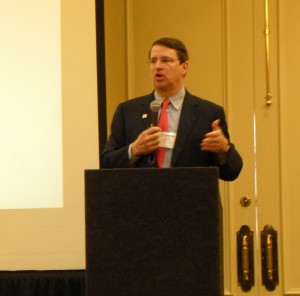 Addressing a crowd of aspiring journalists at the 28th SEJC Convention in Lafayette, John Georges, owner and publisher of The Advocate in Baton Rouge, La., predicted a “bright future” not only for his newspaper but for all news media as the younger generation enters the industry.
Addressing a crowd of aspiring journalists at the 28th SEJC Convention in Lafayette, John Georges, owner and publisher of The Advocate in Baton Rouge, La., predicted a “bright future” not only for his newspaper but for all news media as the younger generation enters the industry.
“Don’t listen to anything they’re saying about your futures,” Georges told the nearly 300 students and faculty members from 31 colleges at the SEJC Onsite Awards Luncheon in Lafayette on Saturday, Feb. 22. “It’s going to be really exciting.”
The convention brought 294 faculty and students from more than 30 schools in the seven-state conference.
Although print readership has been in decline, Georges said, he believes the newspaper industry is entering an age of “revolution.”
“We have young people with technology, video and social networking – all these things that are breaking through the norm and breaking the model,” he said. “I think we’re going back to those revolutionary people that started journalism in its earlier days.”
Georges, 53, purchased The Advocate, the largest daily newspaper in Louisiana, from the Manship family in May 2013.
As a New Orleans businessman, Georges said, he’s confident in his ability to turn a business around and sustain it.
The Advocate is already seeing progress. Under new ownership, it has become one of the few publications in the U.S. to expand its coverage and circulation.
“The Advocate is in a unique situation,” Georges said.
The paper has separate editions in Baton Rouge, New Orleans and Lafayette, which are all surrounded by prosperous suburban areas, he explained.
When the New Orleans Times-Picayune cut its print edition to three days a week in 2012, The Advocate, then under the Manships, came out with The New Orleans Advocate, an enhanced and rebranded edition to compete as a daily newspaper. The company was also able to pick up employees who lost their jobs at the Picayune, Georges said.
“We knew the New Orleans readers wanted to read, and they wanted to read the paper they had grown up with,” he said. “They couldn’t have the Times-Picayune. It’s the paper by name but no longer the paper they’re accustomed to.
“They’re accustomed to reading the seven-day paper,” he continued. “We were able to provide them with seven-day delivery with many of the writers they were accustomed to.”
The New Orleans Advocate is actually making money, Georges said, which makes up for any money the paper could be losing at home in Baton Rouge.
With the same initiative in mind, the company also rebranded the Lafayette edition to become The Acadiana Advocate.
Georges said in both Lafayette and New Orleans, the paper is competing with nationally owned chains, which aren’t as flexible as a locally owned newspaper like The Advocate.
“They have to be profit-driven,” he said. “They can’t do illogical things; they can’t invest in ideas that may or may not pan out because they have to make a profit.”
Louisiana has more than 100 newspapers. Georges said he believes they will consolidate over time and print editions will survive, but the economic side must be left up to business people.
“We’re delivering the newspaper to your home for $1 or less,” he said. “It’s the best bargain in America, and I believe over time people will pay more for that.”
Asked about the relationship between the business side and the editorial staff, Georges replied that the general manager and editors at The Advocate run the paper and control the content because, as journalists, they know best.
“A strong paper never folds over to an advertiser,” he said.
Despite the skeptics, Georges remained hopeful and excited about what’s coming next for the journalism industry.
“I think your future is safe,” he said to the students. “I think it’s going to be different. Everything’s different, but I’d much rather be a journalist today than a med student or a lawyer.”
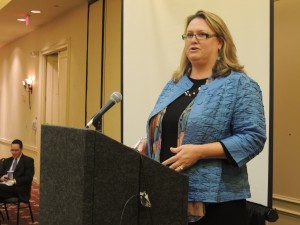 NPR reporter Debbie Elliott detailed the success the public radio network has seen in recent years, saying it provides “perspective about what’s been happening in journalism in the last decade.”
NPR reporter Debbie Elliott detailed the success the public radio network has seen in recent years, saying it provides “perspective about what’s been happening in journalism in the last decade.”
Addressing the Best of the South Awards Banquet during SEJC’s 28th annual convention in Lafayette on Friday, Feb. 21, 2014, Elliott, NPR’s Southern regional correspondent, said NPR has about 34 million listeners each week, 27 million of whom tune in exclusively to the station’s news programs. Even though journalism has declined nationally — with newspapers losing 22 percent of their readers and news networks losing 29 percent of their viewers over the last 10 years — she said NPR has seen a 19-percent hike in listeners.
“Why?” she inquired, holding a jar of tar balls and a tooth from a nutria rat. “These help us answer that question.”
The two props helped illustrate the significance of the kind of stories NPR produces, said the 51-year-old reporter based in Orange Beach, Ala. She called them “evidence I left my computer screen, hung up my telephone and I went somewhere,” telling the more than 290 college students and faculty in attendance that that is “90 percent of your success as a journalist.”
“Your very best work is going to happen when you’re out there on the ground and adapting to what you’re learning and seeing,” said Elliott, a former NPR Capitol Hill correspondent and weekend host of the popular program “All Things Considered.”
Elliott, an Atlanta native and University of Alabama alumna who has worked at NPR since 1995, has extensively covered the 2010 BP oil spill — from which she acquired her collection of tar balls. She said she has produced 136 stories on the subject, covering its lingering, widespread effects that include damage inflicted on economic, ecological and legal levels.
The experience gained through the coverage, she said, has made her a relative expert in oil spills. Because of that, Elliott said, NPR is sending her to Alaska to cover the 25th anniversary of the Exxon Valdez spill, which was considered to be the biggest in U.S. history until the Deepwater Horizon oil spill — as the BP spill is often called — dethroned it four years ago.
“I can tell you the difference between a tar ball and a tar patty,” Elliott said. “There’s a vocabulary to this, and I can tell it to you because I experienced the story.”
Elliott laughed when she said she did not kill the nutria from which the tooth came, but she said she “covered the man who did because they were eating up the marsh in Louisiana.”
With animated imagery, Elliott recalled reporting on nutria “chompin’ up all the marshes,” partly causing Louisiana to lose its wetlands at an alarming rate.
“I actually took my microphone into the swamp to see what they do, and I was able to explain to our listeners in a very vivid way what this issue was,” Elliott said. “That’s something I think NPR does better than just about anybody.”
The Atlanta native explained NPR has 15 U.S. bureaus and 17 foreign ones. Saying that NPR listeners “actually get to experience” what they hear, Elliott described the network’s stories as ones “you can actually touch, feel and smell.”
“It’s important to have people all over the country to reflect the people all over the country,” she said of NPR’s wide coverage. “If people are actually in those communities, it’s much easier to tell real stories about real people.”
Elliot — who has reported only for radio since her first job as a sophomore at the University of Alabama’s public radio station —used these examples to “instill the value of original reporting” in her audience.
“You’ll find there’s not just this side and that side to a story,” she said. “There’s history, there’s context, there’s nuance to a story. See for yourself, look for yourself what the real story is.
“There’s always more to a story,” Elliott continued, “and that’s your job as a journalist to get at that.”
Gene C. Fant Jr., Ph.D., gave the opening address of the 27th annual SEJC convention at Union University in Jackson, Tenn., encouraging his audience to “be committed to truth no matter where it may lead you.”
“The ultimate power of narrative is that it has truth,” Fant admonished his listeners. “Truth is among the most powerful elements in the universe. So when journalism, when narrative, when storytelling embraces the truth, it suddenly begins to be filled with power. We cannot allow ideology to trump our commitment to truth, no matter what our ideology might be. And so this is the ultimate power of narrative that I encourage you all to embrace.”
As an English professor at Union, Fant related the importance of journalists’ accuracy and truthfulness to a piece of literature he assigns as part of his English classes: George Orwell’s classic “1984.” In this work of speculative fiction, Fant explained, the main character’s job is to redact offensive material and facts that have changed from old newspaper articles.
“It really is an image of how the media and journalists in particular influence our collective understandings of events, our collective memories of things — our collective identity even as a society,” Fant said.
Although he writes mostly editorial content for nationally syndicated publications like The Chronicle of Higher Education and First Things, Fant admitted he does “dabble” in journalism, but as more of a raconteur. True to this self-proclaimed identity, Fant began his speech to the SEJC members and advisers by using anecdotes to illustrate how journalists affect public perceptions of events. Through word usage, Fant said, journalists can make any event anything from unforgettable to totally negligible.
The news coverage of the aftermath of a tornado that wracked Union University in February of 2008, Fant said, was “one of the most transforming events” of his life. However, the coverage of a crisis at his high school when someone set fire to the school after setting off a military-grade tear gas canister in 1979 became forgettable to many who had lived through it.
Fant also warned against reporting information hastily, a problem that has compounded as information becomes easily available through the Internet. Specifically, he referred to some faulty journalism that occurred after the shooting in Newtown, Conn., in December.
“There was just misinformation all over the place,” Fant said, “and what struck me was that our national memory of the event was also being influenced by false data. It was journalists, who were there on the scene trying to do their best with the information they were given but who were also being conflated with nonprofessional media, (who were) shaping our eventual memory of how the event took place.”
One of the key contributors to this problem of faulty facts and egregious errors lies in the surge of “news” that spreads unprofessionally through “citizen journalism” on social media sites like Facebook, Fant said. He warned the audience that this citizen journalism has a distinct “dark side.”
“Anyone with an iPad suddenly has a camcorder and access to the Internet, and they can say anything they want to say and report anything they want to report,” Fant explained. “Now the problem with that is: How do we know the accuracy of these things?
“These are not people who have journalistic standards,” Fant continued. “They aren’t looking for any of the classic things we teach in our programs. Instead, what we have are live eyewitnesses with opinions.”
To combat this, Fant stressed the importance of professionalism in journalism, because the surge of citizen journalism can adversely affect not only the memory of incidents in the annals of history but also the perceptions of the profession.
To correct what Fant described as a weakening in the profession, he encouraged those future journalists listening to fight to uphold the principles of truth and honor in reporting. Only by adhering to this code, he said, would journalism become revitalized and the power of narrative restored.
“How do we carve out a future for journalism in the era of citizen journalism and digital democracy if we do not dedicate ourselves to utter truthfulness?” Fant asked the crowd. “How do we maintain our reputations as shapers of the democratic impulse? If everyone else is being unreliable, we must be reliable, and we do this through our truthfulness.”
 The outlook seems bleak: Print subscriptions are down, and papers are waning in size. However, the shift doesn’t signify a decline in readership, but rather a shift in how news is delivered, said executive editor Steve Coffman of The Jackson Sun in Tennessee.
The outlook seems bleak: Print subscriptions are down, and papers are waning in size. However, the shift doesn’t signify a decline in readership, but rather a shift in how news is delivered, said executive editor Steve Coffman of The Jackson Sun in Tennessee.
“So often you’re going to hear, ‘These papers are dead. They’re dying. They’re losing subscribers. There’s no future in it,’” he said before students from seven states at last month’s Southeast Journalism Conference at Union University. “But I don’t think so. We have a good case to make.”
The award-winning, 26-year news veteran also serves as the paper’s director of content and audience development, and as technology progresses, Coffman said, so does journalism’s reach.
“We have lost subscribers to our print product,” he admitted. But at the same time, he continued, the loss has created instead a “vivid, visual audience going up, up, up, up in some pretty significant ways.”
This adapted audience has become privy to technology. Smart phones and tablets provide readers with news coverage at any time and in any situation, so news companies—like Gannett Co., Inc., the country’s largest media corporation that owns The Jackson Sun—are forced to adapt or sink. But these advances are inevitably expanding beyond websites.
“At Gannett,” Coffman said, “we’ve got an app for that!”
And it does. The “Full Access Plan” to any Gannett-owned paper provides that access to articles on the paper’s website and an application providing the day’s news stories. Readers can also choose to use the e-edition app, which, instead of listing articles, shows a digital form of the paper in its printed layout.
The shift in news delivery also prompted a shift in Gannett’s pay model. Those who visit Gannett websites but do not subscribe are allowed a certain number of free articles, the sum of which is based on readership characteristics about the surrounding market. Jacksonsun.com, for example, allows for 20 free articles per month before requiring a subscription, which costs $12 for digital-only, and $10 for both digital and print. Theadvertiser.com in Lafayette, La., however, only allows for 10: But its subscriptions cost $9 whether purchasing digital-only or both digital and print subscriptions.
As fast-paced, often citizen-based news coverage is on the rise, though, Coffman said news organizations must continue going above and beyond to answer the questions no one is asking. He cited a story uncovered by The Jackson Sun that questioned the suicide of an inmate while he was on suicide watch. The Sun’s coverage, Coffman said, pushed the jail to enact policy changes that may save lives in the future.
“If we, as a newspaper, aren’t asking those questions, aren’t doing that digging, who’s going to?” he said. “I don’t think anybody’s going to.”
Gannett also positions its papers to maintain readership through market research, Coffman said, that tackles readers’ “passion issues”—like faith or public safety.
“We make sure that our reportage and our structure is aligned to be covering those topics better than anybody else, and I think that we are doing that,” he said.
According to web information company Alexa, Coffman said, Jacksonsun.com ranked last month as 112,000th in the world. (To put it in perspective, a March 2012 survey reported by the San Francisco Chronicle totaled the world’s active websites at around 644 million.)
In January, the site had 3 million page views. It peaked in 2008, when 268,500 individual computers visited it after tornadoes blasted through Union University and garnered national attention.
“That’s a better audience than we’ve ever had as a print product,” Coffman said.
Jackson’s local television station, he said, is about 300,000 places behind The Jackson Sun in Alexa’s ranking, while the local talk radio show goes back about 3.3 million.
“I think there’s a good argument to be made there,” Coffman said, “that we have a lot more room to grow, even as all of these ways of reaching people continue to change and evolve.”
Gannett owns 81 additional daily newspapers, including nationally circulated USA Today. Its broadcasting division reaches 21 million households via 23 television stations and covers 18.2 percent of the U.S. population, according to gannett.com. The media giant also owns the British publisher Newsquest, which produces more than 200 publications.
But as the technological tides change exponentially year after year, will the presses continue rolling?
“I don’t want to let anybody think we’re going to forget (print),” Coffman said, “but obviously, a lot of people want to get their news in different ways, and we’re adapting to that, and changing that. It’s not just about newspapers anymore.”
“Video has become a key component in journalism, public relations and communications in the world of a digital media,” said award-winning reporter, producer and writer Kim Lawton. “Video is an important factor in telling a story.”
Lawton, the managing editor and correspondent for the half-hour PBS TV show “Religion & Ethics NewsWeekly,” was the first speaker to take the stage on Saturday, Feb. 23 at Union University. The conference boasted attendance from more than 30 schools from Alabama, Arkansas, Georgia, Florida, Louisiana, Mississippi and Tennessee.
“(Video is) like a puzzle, or a tapestry,” Lawton said. “There’s a real art to it because I’m weaving together (the story). My friends who are print journalists have to worry about doing concepts, but I have to worry about how to illustrate those concepts.”
Lawton’s showed brief video samples of her work to accentuate her point. From heart-wrenching, high-definition hospital shots to shards of history with Martin Luther King Jr., Lawton only revealed slivers of her face during her subject-focused broadcasts.
“You need the words to explain, but the power comes from the image,” said Lawton. “As journalists, if that’s where your power is, that’s what you play.”
Lawton, who earned her bachelor’s degree in communication with an emphasis in journalism at Messiah College in Pennsylvania, urged students to study and utilize video in their journalistic “tool shed” as a method of compelling storytelling. She cited a UCLA report that segmented the three elements of communication into word choice, vocal tone and body language, which dominated communication impact with 55 percent of the overall influence on the audience.
Her initial focus was in radio broadcasting, but she said she picked up video skills along the way as she progressed in the field. Lawton shared one tip she learned: “Don’t be married to your notes.” She listed crucial keys to successful interviews, such as maintaining eye contact, pursuing the actual conversation, foregoing notes to fully engage, avoiding distraction and making the interview subject comfortable and relaxed to get to the “nut” of the story.
As more and more papers ask reporters to shoot video while on assignment, Lawton said modern-day journalists must accommodate. She described her work as a “team effort,” because she often works with a producer, editor, camera operator and audio expert while building the story. However, she admitted this is a luxury most publications and papers cannot afford.
“One of my concerns is that in the rush to become a one-man band, I hope that we don’t have a lessening of quality,” Lawton said. “I hope that we have a higher standard because I think that contributes to telling a compelling story.”
Another frustration Lawton said she experienced in her field is what she called the superficial distractions of video.
“Sometimes, the strength of video is also a weakness in that the visual becomes so important,” she said. “I get frustrated (when) I’m telling this really great story and the only thing people care about is I have this one hair hanging down funny in the middle of the story. That drives me nuts.”
Lawton said these issues are worth fighting through, because journalists are privileged with the gift of telling stories “that may otherwise be lost.”
“Video certainly has its own universe,” she began, “its own language, and you need to understand what that is.”
Almost 300 future photographers, editors, reporters and layout designers crowded into the Carl Grant Events Center at Union University to listen to keynote speaker Larry McCormack’s blunt advice on staying ahead and going the extra mile in a field that is constantly changing: journalism.
“Think differently, (and) challenge yourself,” said McCormack. “If you have the safe shot, then you have the safe shot. Now, move on. Don’t stay there. You know who has the safe shot; 90 percent of the people, and if you want to be there, you’ll be with 90 percent of the people. If you want to be in the top 10 percent of people, you have to do the things that the top 10 percent do.”
McCormack, a 30-year photographer and 14-year veteran of The Tennessean in Nashville, witnessed dramatic changes in journalism, especially the change in photojournalism from black and white to color, as well as the evolution to digital media. He has also adapted to social media, audio podcasting, video and other multimedia platforms, which he now does on a regular basis.
“In media today, you are going to do all this,” said McCormack. “You’re going to copywrite; you’re going to do video; you’re going to edit; you’re going to do audio. If you’re not doing that, you’re not going to last long. If you are a good photographer, a good reporter, a good copy editor, you are going to be sought after.
“Out of this class here, probably about 10 percent of you guys are going to find jobs in the field that you want to be in,” added McCormack. “The top 10 percent are going to come out winners. The other 90 percent, I’m sorry.”
Although McCormack’s outlook may seem bleak, he did offer advice that could potentially help set the SEJC listeners apart from other fledgling journalists who are entering the field.
“When I was young, I saw a presentation by Brian Lanker, and it changed my life,” said McCormack. “I liked his style, so I tried to copy him. Guess what happened. I’m not as good him, but I developed my own style–a style that I hope brands me as who I am, and allows me a different look at photographs. What you need to do is develop your own style and brand yourself.”
To develop a style, McCormack suggested thinking differently and changing perspectives, along with diligent practice, research and study.
“You want to be on the intellectual (level) of whoever this person is,” said McCormack. “Not to the point that they are, but you need to know enough, so you can hold an intelligent conversation. There is a reason most of you guys are getting a liberal arts degree. It’s so you can communicate. It’s so that you can talk to people, and you can communicate that (what you discovered) back to your community.”
McCormack also reiterated that taking the safe option isn’t going help, especially when trying to create a distinguished piece, and he challenged the audience to go out into the field and take risks.
“If you stay where you are safe, you are not doing your job,” said McCormack. “Don’t take the obvious. Don’t take the ordinary. Whatever obstacle you have that shows up in front of you is not an obstacle; it is an opportunity.”
Steve Duin, The Oregonian’s metro columnist for 18 years, encouraged attendees at the SEJC convention to find the place where “your deep gladness and the world’s deep hunger meet,” a concept he said is at the heart of journalism’s future.
The centerpiece of Duin’s speech was the story of Portland’s Roosevelt High School, a subject he said he discovered after perusing the sports section in January 2009. The box score recounted Roosevelt’s girls’ basketball team’s 88-10 loss in front of a crowd of 10. One player, Togo native Ahoefa Ananouko, scored eight of Roosevelt’s 10 points.
When Duin arrived to write about the team a month later, he said he realized Ananouko’s amazing story, which included living in a refugee camp in Benin for seven years after her father spoke out against Togo’s dictatorship, wasn’t the story he was there to tell. He was there to tell his readers why there were only three parents at the game for the 10 “stubborn survivors” on the basketball team.
“The missing parents had decent excuses — they were working two minimum wage jobs, they couldn’t afford the bus pass or the $6 ticket,” the basketball coach told Duin.
Then, the kicker: there were five seniors on the team the year before, and on the last home game, “not a single parent was there to walk their daughters to center court,” the coach told Duin. “The kids were asking me, ‘Who’s going to walk me down?’ It hurt to look in their faces.”
When he wrote his column about Roosevelt’s basketball team, he ended it with, “The girls’ final home game of the season is next Tuesday against Madison. I promise you, one parent will be there. Anyone care to join me?”
One thousand six hundred people showed up to that final basketball game, where Roosevelt lost by two points.
“What I discovered there convinced me I was at the place where my deep gladness and the world’s deep hunger met,” said Duin, who is the brother of Union journalism professor Julia Duin (see related story on snake handlers). “I went back to Roosevelt because my newspaper still allows me to share the great stories wherever I find them.”
His columns on Roosevelt, which revolved around a 16-year-old cornerback with a 2-year-old daughter, the struggles of 110 of the 700 kids at Roosevelt who were homeless, and the return of a pro football player who volunteered to help coach the team, created a domino effect.
One reader, Kirsty Dickinson, called the football coach and asked if they ever had team dinners after reading about a player who told the coach he hadn’t eaten in a couple of days because of money issues at home. The coach told her they didn’t have the funds to do it, and she showed up that week with enough pasta and cookies to feed 45, and continued to feed the team every Wednesday, even as other athletes and school employees made the number swell to 85 — a realization of the story of five loaves and two fish.
“’We believe we are called to love the world,’” a volunteer told Duin, a quote he called his favorite line of the year, “’and the older I get, the more love looks like work.’”
Duin’s work, he said, is to write for a daily paper, despite the industry’s outlook.
“It is a daunting time to subscribe to that delusion,” said Duin. “In my lifetime, I have seen the morning paper evolve from the final authoritative word on the matter to a largely irrelevant afterthought. Those of us who remain are left with few illusions about where this is going. We’re playing the dinner music on the sloping deck of the Titanic.”
When the Portland school district was working to redesign the district, the football coach told him Duin saved his job, because after the attention Roosevelt garnered from Duin’s columns, there would be public outrage. That evening, Duin said he realized Roosevelt had saved his job, too.
“Just about the time giving up was becoming fashionable in the newspaper business, you and Roosevelt came along with your deep hunger and somehow found your way to my deep gladness,” he said. “Maybe when we finally find the place of hunger and gladness that was designed especially for us, we can finally relax and devote ourselves to helping others find the place that was designed especially for them.”
Duin said he is able to share his stories because he has “total carte blanche” at The Oregonian, and gleans his topics from friends and reader suggestions. At times, however, he said he does have a shortage, which is when he takes a walk and talks to strangers, “because pretty much everybody has a doggone good story hidden somewhere inside of them.”
Julia Duin, a journalism professor at Union University, explained how she used her 40 years of journalistic experience to successfully cover Appalachian snake handlers and captivate the world with her story.
Duin’s story on snake handlers led her to three Pulitzer Prize nominations and articles for The Washington Post, Wall Street Journal and cnn.com. Duin gave advice to the SEJC attendees on how to create a story as successful and captivating as her documentation of serpent handling.
“One, don’t be afraid to get out of the box and report on something totally new and different. What is radical yesterday is commonplace today,” said Duin. “Don’t be afraid to ask the uncomfortable questions. We live in a world where there is very little moral courage and there are few convictions and no endurance when it comes to standing up for beliefs. Often it is not the most talented people who get the job done, but it is the most persistent, the most curious, the daring, the ones who didn’t give up. It means asking question after question and risking unpopularity for bringing truths that people don’t want to hear.”
Duin recounted that she had been laid off in 2010 from the Washington Times and had been working as a freelance journalist when she received an opportunity from a photographer friend to cover fundamentalist snake handlers in West Virginia.
“Newspaper reporters always hope that we find that one big story that makes it around the world,” said Duin. “I’ve been reporting for newspapers and magazines since I was in high school, so we’re talking about 40 years, but last May I did write a story that went all over the world and it had to do with a radical form of Christianity that most people don’t agree with.”
“So I went to West Virginia; packed my 7-year-old daughter in the car and sat for three days in endless church services and what we saw was this story,” recalled Duin. “I researched what had been done on serpent handling and I found out that very little had been done in the last 20 years; the only ones I found had been done in the 1990s. We spent five days in that corner of West Virginia, again the non-touristy region. I was continually either horrified or fascinated.”
Duin recalled the moment she realized the story’s hook had changed. Once she became familiar with the practice, she realized that 20-somethings were its guiding force and her story shifted, changing the course of her documentation.
“We found out (that) the way that this custom was spreading was not just by visiting preachers, but by Facebook,” Duin said. “All these young handlers were posting photos on their Facebook accounts. I thought ‘Here you go; this is a new story.’ When I got ahold of the Wall Street Journal, my hook was ‘Hey, this isn’t fading away after all; it’s now spreading among 20-somethings.’ They bought the story; it ran the day before Easter, and it got 37,000 hits over Easter weekend. Folks — that’s the kind of story you want to have.”
Duin said she never imagined she would become an authority on snake handling, but she was called to continue her narration on the topic after Mack Wolford, one of the 20-somethings spotlighted in her story, sustained a fatal snake bite at an Evangelistic rally.
“The story I put together for his death went online at 8:45 p.m. the next day; within two hours it was trending as a top story on their (The Washington Post) site for about 36 hours,” said Duin. “It got more than 1,300 comments. I redid the story for cnn.com that got 6,500 comments. Everyone wanted to know how this man had died. My byline was all over the country and overseas. I got on Facebook and I read some of the comments from other serpent handlers, and it was clear the people up and down Appalachia were tortured and traumatized by his death.”